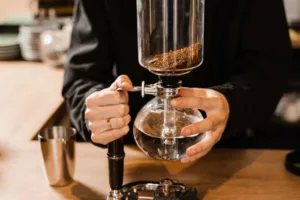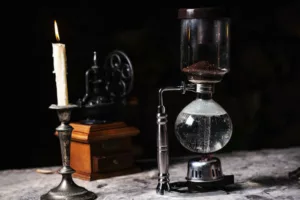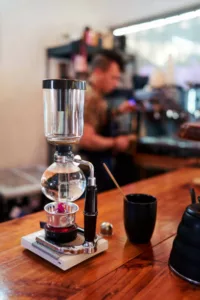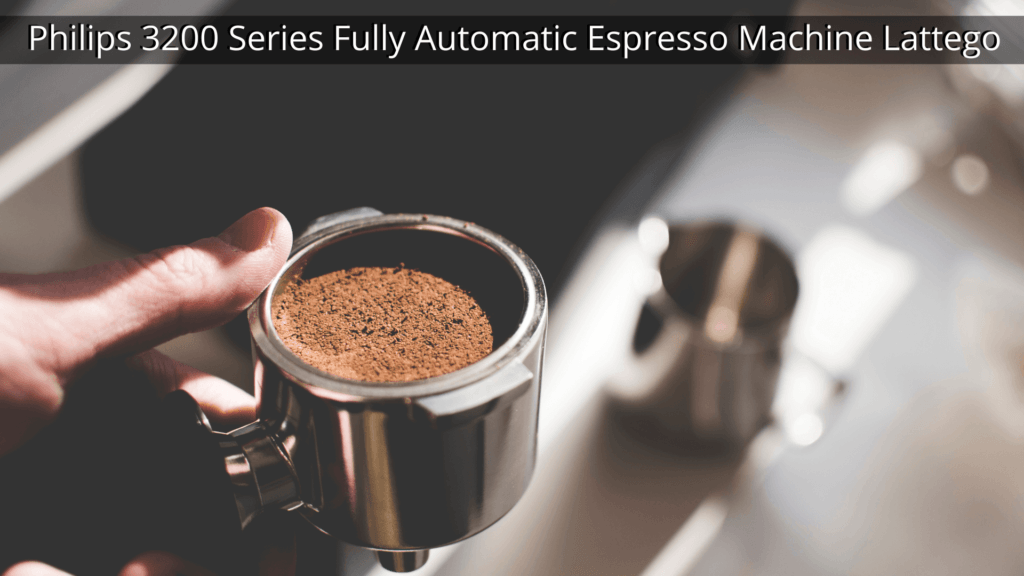Here’s a brief history of the Japanese siphon coffee maker:
Picture this: it’s the early 19th century in Japan, and a group of caffeine-obsessed coffee lovers are huddled around a brewing contraption that looks like a science experiment gone wrong. The device comprises two glass globes stacked on top of each other, with a tube connecting them. But what is it, you might ask? Why, it’s the birth of the Japanese siphon coffee maker, of course!
Legend has it that the siphon coffee maker was invented by a French woman named Madame Vassieux in the 1830s. But the Japanese quickly fell in love with the unique brewing method and began producing their own versions of the device.
Fast forward to the present day, and the Japanese siphon coffee maker has become a staple in the world of specialty coffee. Known for its precise brewing method and distinctive flavor profile, the siphon brewer has gained a loyal following among coffee enthusiasts.
But why go through all the trouble of brewing coffee with a siphon, you might ask? Well, it’s a great way to impress your friends and show off your coffee-making skills. Plus, the siphon brewing method allows for greater control over the brewing process, resulting in a cleaner, more nuanced cup of coffee.
So there you have it, folks. From Madame Vassieux to the coffee-loving innovators of Japan, the siphon coffee maker has come a long way. And while it may look like something out of a chemistry lab, there’s no denying the delicious, perfectly brewed coffee that it produces. Cheers to the siphon!
“Unlock the Flavor: Why a Japanese Siphon Coffee Maker is the Key to a Perfect Cup”
Are you tired of the same old boring coffee? Do you want to impress your friends with your mad scientist coffee-making skills? Look no further than the Japanese siphon coffee maker.
One of the biggest benefits of using a Japanese siphon coffee maker is the control it gives you over the brewing process. With its unique design, the siphon allows you to carefully monitor the temperature and timing of your brew, resulting in a perfectly balanced cup of coffee every time.

But the siphon isn’t just a pretty face – it’s also known for producing a clean, flavorful cup of coffee. The siphon brewing method allows for thoroughly extracting the coffee grounds, resulting in a rich, nuanced flavor profile. And because the coffee is brewed with hot water vapor, it’s less likely to come into contact with any sediment or impurities that can affect the taste.
And let’s not forget the entertainment value of using a siphon coffee maker. Your guests will be amazed as they watch the coffee bubble up and down the tubes like a lava lamp. Plus, it’s a great conversation starter – who wouldn’t want to discuss the intricacies of coffee brewing over a hot cup of siphon-brewed coffee?
Of course, there are a few downsides to using a siphon coffee maker. It’s definitely not the most convenient brewing method, and it can take a bit of practice to get the hang of it. But once you do, you’ll be rewarded with a truly exceptional cup of coffee that’s sure to make you the envy of all your coffee-loving friends.
So there you have it – the benefits of using a Japanese siphon coffee maker. It may be a bit of a learning curve, but the results are well worth it. So go forth, coffee lover, and brew your way to the perfect cup with a Japanese siphon coffee maker.
related article – the ultimate guide:
how to make perfect coffee at home
How To Make Perfect Coffee at Home? Are you kidding me? Who needs a guide for that? All you need is a bag of coffee, some hot water, and a prayer to the caffeine gods, right? Wrong! Making perfect coffee is an art form, a delicate balance of science and wizardry that requires the right … Read The Full Story Here

“Brew Like a Pro: A Step-by-Step Guide to Mastering the Japanese Siphon Coffee Maker”
Brewing coffee with a Japanese siphon coffee maker may seem intimidating, but fear not! With a little practice and the right equipment, you’ll be brewing like a pro in no time.
In this guide, we’ll cover everything you need to know to get started with a Japanese siphon coffee maker, from understanding the different parts of the brewer to perfecting your brewing technique. Here’s a sneak peek of what we’ll cover:

First, we’ll take a deep dive into the Japanese siphon coffee maker and its unique design. You’ll learn about the different parts of the brewer and the materials used to make it, as well as how the siphon brewing process actually works.
Next up, we’ll dive into the nitty-gritty of preparing for brewing. We’ll cover everything from choosing the right coffee beans to grinding them to the perfect consistency, as well as measuring out the right coffee-to-water ratio and preheating your siphon coffee maker.
Then, it’s time to brew! We’ll guide you step-by-step through the brewing process, including tips for achieving the perfect cup of coffee and common mistakes to avoid.
Once you’ve mastered the art of siphon brewing, we’ll show you how to clean and maintain your siphon coffee maker to keep it in tip-top shape.
So if you’re ready to take your coffee game to the next level, grab your Japanese siphon coffee maker and let’s get brewing!
Understanding the Japanese Siphon Coffee Maker
If you’re going to brew with a Japanese siphon coffee maker, you’ll need to get familiar with the different parts of this unique brewing device. It may look like a science experiment gone wrong, but we promise – once you get the hang of it, you’ll be a siphon-brewing pro in no time.
So, what are the different parts of a Japanese siphon coffee maker? Let’s take a look:

- The bottom chamber is where you’ll add your water before brewing. It’s typically made of glass and can be shaped like a globe or a cylinder.
- The top chamber: This is where the brewed coffee ends up. It’s also made of glass and is usually attached to the bottom chamber with a tube.
- The tube: This is what connects the bottom and top chambers and allows the water and coffee to move between the two. It’s usually made of glass and can be straight or curved.
- The filter: This is what separates the coffee grounds from the brewed coffee. It’s typically made of metal or cloth and sits at the neck of the top chamber.
Now that you know the different parts of a Japanese siphon coffee maker, let’s talk about the materials used to make it. Most siphon coffee makers are made of glass and metal, with some plastic parts. This allows for a clean, chemical-free brewing process and also makes for a visually striking brewing device.
But it’s not just about the materials – the design of the siphon coffee maker is also key to its brewing process. By using a vacuum to brew the coffee, the siphon allows for a precise and even extraction of the coffee grounds, resulting in a clean, flavorful cup of coffee.
How A Japanese Siphon Coffee Maker Works
At first glance, a Japanese siphon coffee maker may seem like something from a science fiction movie. But once you understand how it works, you’ll see that it’s actually a pretty straightforward brewing method.
Here’s the basic process:
- First, you’ll add water to the bottom chamber of the siphon coffee maker.
- Next, you’ll place the top chamber on top of the bottom chamber, so that the two are connected by a tube.
- Now, it’s time to add coffee grounds to the top chamber. Depending on the size of your siphon coffee maker, you’ll typically use anywhere from 20 to 40 grams of coffee.
- Once your coffee grounds are in place, you’ll heat up the bottom chamber with a heat source, such as a butane burner or an alcohol lamp.
- As the water in the bottom chamber heats up, it will begin to move up the tube and into the top chamber, where the coffee grounds are waiting.
- Once the water reaches the coffee grounds, it will begin to extract the flavor and aroma of the beans, creating a rich and flavorful coffee.
- As the coffee brews, it will begin to move back down the tube and into the bottom chamber, thanks to the vacuum pressure created by the heating and cooling of the water.
- Once all of the brewed coffee has moved back down into the bottom chamber, you’ll remove the heat source and carefully separate the top and bottom chambers, being careful not to burn yourself on the hot glass.
- Finally, you’ll pour your freshly brewed coffee into your cup, sit back, and enjoy!
So there you have it – the basic process for brewing coffee with a Japanese siphon coffee maker.
Japanese Style Siphon Coffee Maker

These devices, also known as siphon coffee makers, are a unique and beautiful way to brew coffee, using a combination of heat and vacuum pressure to extract the flavors and aromas from your coffee beans. With a little practice and patience, you can create a delicious, perfectly balanced cup of coffee with a Japanese-style siphon coffee maker. So why not give it a try and see what all the fuss is about?
Price At Time Of Publish – $46
Preparing for Brewing With A Japanese Siphon Coffee Maker
Brewing with a Japanese siphon coffee maker is a unique experience, and it all starts with preparation. Here’s everything you need to know to get ready for the perfect cup of siphon-brewed coffee:
Choosing The Right Coffee Beans
The first step to brewing great coffee is choosing the right beans. When it comes to siphon brewing, you’ll want to look for beans with a medium to light roast. This will allow the unique flavors and aromas of the coffee to shine through without being overpowered by a dark roast.
Of course, you’ll also want to ensure you choose high-quality beans. After all, the better the beans, the better the coffee. So, splurge on that specialty coffee – your taste buds will thank you.
related article – Why arabica coffee is so popular
Have you ever wondered why Arabica Coffee is so popular, I know I did before taking that first wonderful sip! I think I was about 35 years old when I had my first sip of Arabica coffee. My friends and I were in a local café, trying to study for our upcoming exams (I was … Read More >>

Grinding Coffee Beans For Siphon Brewing
Once you’ve chosen your beans, it’s time to grind them. For siphon brewing, you’ll want to grind your beans to a medium-fine consistency, similar to the texture of sea salt. This will allow for even extraction and a clean, flavorful cup of coffee.
But be warned – grinding coffee for siphon brewing can be a bit of a workout. So get ready to break a sweat (or enlist the help of a burly friend)!
Measuring Coffee And Water Ratios
Next up, it’s time to measure out your coffee and water. The general rule of thumb for siphon brewing is to use one gram of coffee for every 15 grams of water. But don’t worry too much about getting the exact ratio – finding a ratio that works for your taste preferences is more important.
And speaking of personal taste preferences, feel free to experiment with different coffee-to-water ratios until you find the perfect balance. After all, brewing coffee should be fun and enjoyable!
Preheating The Siphon Coffee Maker
Lastly, don’t forget to preheat your siphon coffee maker before brewing. This will help to ensure an even temperature throughout the brewing process, resulting in a smoother, more balanced cup of coffee.
To preheat your siphon coffee maker, simply fill the bottom chamber with hot water and let it sit for a few minutes before brewing. And while you’re waiting, why not take a moment to do a little coffee-themed dance to get in the brewing mood?
So there you have it – the four key steps to preparing for brewing with a Japanese siphon coffee maker. With the right beans, the perfect grind, a balanced coffee-to-water ratio, and a preheated brewing device, you’ll be well on your way to the perfect cup of coffee. Happy brewing!
related article – master making a good cuppa at home
Today, we will show you how to make a good cup of coffee at home that will rival any coffee shop brew. Are you tired of mediocre coffee that just doesn’t hit the spot? Are you tired of shelling out your hard-earned cash for a cup of Joe that leaves you wanting more? Well, fear … Read More >>

The Japanese Siphon Coffee Maker Brewing Process
Here’s a step-by-step guide to brewing with a Japanese siphon coffee maker, as well as tips for achieving the perfect cup of coffee and common mistakes to avoid:
A. Step-by-Step Guide to Brewing with a Japanese Siphon Coffee Maker:
- Measure out your desired amount of water and pour it into the bottom chamber of the siphon coffee maker.
- Place the top chamber on top of the bottom chamber and secure it in place with the filter.
- Place your ground coffee in the top chamber.
- Light the heat source and place it under the bottom chamber.
- As the water heats up, it will begin to rise up into the top chamber and mix with the coffee.
- Stir the coffee grounds gently to ensure even extraction.
- Once all the water has moved up into the top chamber, remove the heat source and let the coffee brew for 30-60 seconds, depending on your preferred strength.
- Remove the heat source and wait for the brewed coffee to move back down into the bottom chamber.
- Once all the coffee has moved back down, carefully remove the top chamber and filter.
- Pour your freshly brewed coffee into your cup and enjoy!
B. Tips for Achieving the Perfect Cup of Coffee:
- Use high-quality beans that are freshly roasted and ground.
- Experiment with different brewing times and ratios to find what works best for your personal taste.
- Stir the coffee grounds gently during brewing to ensure even extraction.
- Preheat the siphon coffee maker before brewing to ensure an even temperature throughout the brewing process.
C. Common Mistakes to Avoid:
- Using beans that are too darkly roasted, which can result in a bitter taste.
- Grinding the beans too coarsely can result in a weak, under-extracted cup of coffee.
- Overfilling the siphon coffee maker, which can result in overflowing and a mess.
- Not preheating the siphon coffee maker can result in uneven extraction and a less flavorful cup of coffee.
By following these steps and tips and avoiding common mistakes, you can brew a delicious and perfectly balanced cup of coffee using a Japanese siphon coffee maker. So go ahead and impress your friends and family with your coffee-making skills!
related article – what are the top 10 coffee beans & why?
Coffee is one of the most popular beverages in the world, enjoyed by millions of people every day. With so many different types of coffee available, it can be difficult to know which ones are the best and what sets them apart.
Read Our Coffee Lovers Guide To Find Your Perfect Cup Here.

Cleaning and Maintenance Of Your Japanese Siphon Coffee Maker
Below is a guide to cleaning and maintaining your Japanese siphon coffee maker:
A. Proper Cleaning and Maintenance of the Siphon Coffee Maker:
Cleaning and maintaining your siphon coffee maker ensures a long, happy brewing life. Here are the steps you should follow to keep your siphon coffee maker in tip-top shape:
- Disassemble the siphon coffee maker and separate all the parts.
- Rinse the bottom and top chambers with warm water to remove any residual coffee or debris.
- Use a soft brush or cloth to clean the tube and filter thoroughly. You can also use a mild detergent or vinegar solution to remove any stubborn stains.
- Rinse all the parts thoroughly with warm water and dry with a clean cloth.
- Reassemble the siphon coffee maker and store it in a dry place until your next brew.
B. Tips for Extending the Life of Your Siphon Coffee Maker:
- Always carefully handle the siphon coffee maker, as the glass can be delicate and breakable.
- Store the siphon coffee maker in a dry place, away from direct sunlight and heat sources.
- Use only high-quality beans and water to ensure the best possible brewing experience and to prevent any damage to the siphon coffee maker.
- If you’re not using your siphon coffee maker regularly, it’s a good idea to clean and dry it thoroughly before storing it away.
C. Troubleshooting Common Issues:
- If the siphon coffee maker is not brewing properly, ensure that all the parts are securely fastened and that there are no blockages in the tube or filter.
- If you notice any cracks or chips in the glass, stop using the siphon coffee maker immediately and replace any damaged parts.
- If you’re having trouble with the heat source, ensure it’s properly aligned with the bottom chamber and that the flame is not too high or too low.
By following these tips for cleaning and maintenance and troubleshooting any common issues, you can keep your Japanese siphon coffee maker in excellent condition for many years of delicious brewing. So go forth and brew on, coffee lover!
Japanese Siphon Coffee Maker Conclusion
We hope this guide has helped you to understand the unique and exciting world of siphon coffee brewing. From choosing the right beans to perfecting your brewing technique, we’ve covered everything you need to know to start with a Japanese siphon coffee maker.
We’ve discussed the parts and materials of a siphon coffee maker, the preparation process, and the steps to brewing the perfect cup of siphon-brewed coffee. We’ve also talked about common mistakes to avoid, troubleshooting tips, and how to clean and maintain your siphon coffee maker.
Brewing coffee with a Japanese siphon coffee maker is a unique and exciting experience that can take your coffee game to the next level. We encourage you to try it out and discover the amazing flavors and aromas this brewing method can bring out in your coffee.
Remember to be patient and have fun as you start brewing with your Japanese siphon coffee maker. Experiment with different coffee-to-water ratios, brewing times, and grind sizes until you find the perfect balance for your personal taste.
And finally, don’t forget to share your love of siphon coffee brewing with your friends and family. The more people who appreciate the beauty of this brewing method, the better!
So go forth and brew confidently, and don’t forget to savor every sip of your perfectly brewed siphon coffee.
Ready to take your coffee brewing skills to the next level? Grab a Japanese siphon coffee maker and start brewing today! And if you found this guide helpful, be sure to share it with your fellow coffee lovers. Happy brewing!
In a family of coffee addicts, Mark started to appreciate the drink fairly late – around 35 years old.
His love for java began when he wrote articles on it and bought his first machine after which everything else just fell into place; there are now five machines in our home!
We start every day with an early morning cuppa coffee because what could better help set your mind right than some freshly brewed hot Coffee?
When Marks not writing or thinking about coffee, he can be found sipping on a cup of black gold at one of his favorite local joints.




